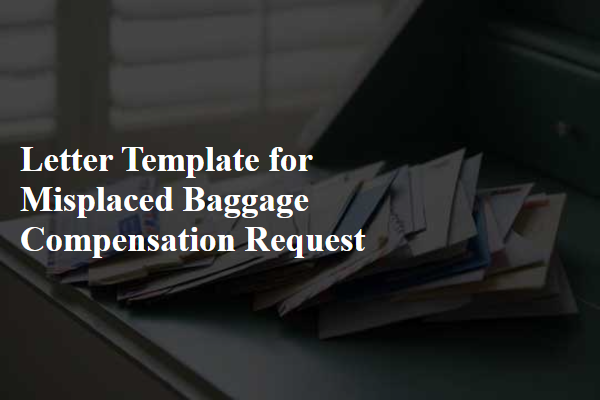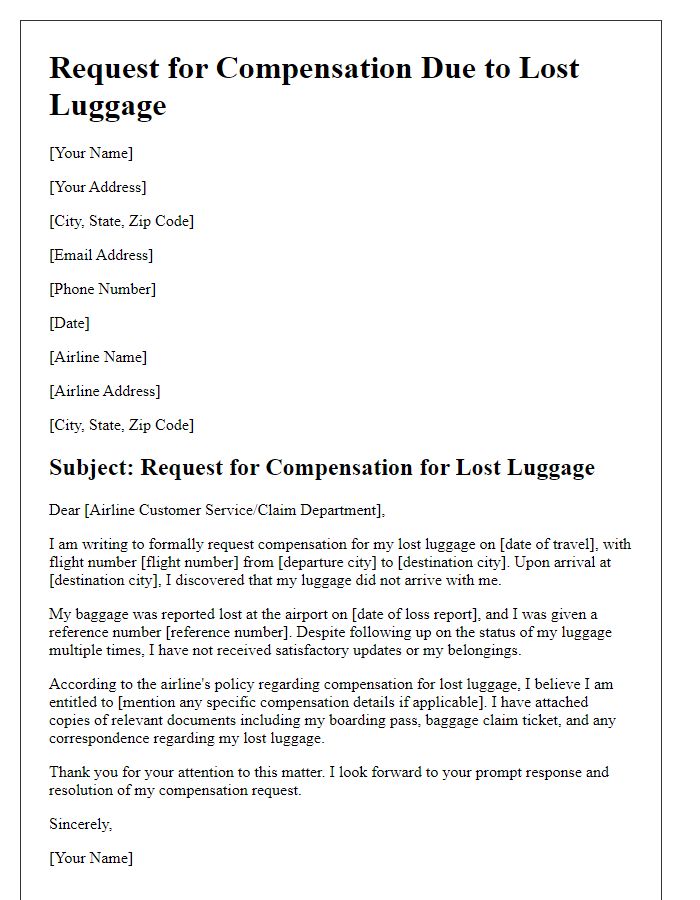Have you ever experienced the frustration of misplaced baggage during your travels? It can turn an exciting trip into a stressful ordeal, especially when your belongings go missing. In this article, we'll explore how to effectively draft a compensation request letter to the airline that lost your luggage, ensuring you communicate your concerns clearly and professionally. So, if you want to learn how to navigate this process smoothly, keep reading!

Personal Information and Contact Details
Personal information is essential for processing a misplaced baggage compensation request. Full name, as per passport or ticket, is required for identification. Contact details, including an active email address and phone number, should be provided for correspondence. Reservation number from the airline ticket enables them to trace the travel itinerary. Flight details, including departure and arrival dates, along with the flight number, assist in locating the lost baggage records. Address, specifically including city and postal code, is necessary for any future communicative needs. Providing accurate information streamlines the claim process, ensuring a prompt response from the airline regarding compensation for the inconvenience caused.
Flight and Baggage Details
Passengers often face significant inconvenience due to misplaced baggage. Travelers flying with major airlines, such as Delta Airlines or British Airways, frequently report issues related to delayed luggage. Compensation request submissions require specific flight details including flight number (e.g., DL1234) and date of travel (e.g., April 15, 2023) to ensure accurate processing. Essential information about the baggage, such as the claim number provided upon reporting the issue, assists airline representatives in tracking lost items. Documentation, including boarding passes and luggage tags, serves as vital evidence to support claims. Airlines typically outline compensation policies that vary based on duration of delay and value of lost items, emphasizing the need for prompt submission of requests.
Description of the Incident
A misplaced baggage incident occurred on October 12, 2023, at Chicago O'Hare International Airport (ORD) following Flight AA123 from New York John F. Kennedy International Airport (JFK). Upon arrival, baggage carousel number 5 displayed an extensive wait time yet my suitcase failed to appear. The suitcase, a black Samsonite hard-shell model weighing approximately 23 kilograms, contains valuable personal items, including business attire worth around $500 and essential travel documents. Despite reporting the issue immediately to the airline's baggage service office, and providing them with a distinct baggage claim sticker number, no updates were provided for over 48 hours. This unfortunate delay disrupted my travel plans and resulted in unforeseen expenses, prompting the need for a compensation request for the inconvenience caused.
Compensation Request and Justification
Misplaced baggage often causes significant inconvenience for travelers. Airlines, such as Delta or United, must address these issues promptly to maintain customer satisfaction. The International Air Transport Association (IATA) defines baggage mishandling as a serious concern, with millions of bags reported missing annually, particularly during peak travel seasons like summer vacation. According to a 2022 report, airlines faced claims averaging $1,500 per passenger for lost luggage, covering expenses for essentials such as clothing, toiletries, and transportation. Passengers experiencing delays due to misplaced baggage may also encounter emotional distress, loss of personal items, and disrupted travel plans. Compensating affected travelers is essential for airlines to uphold their reputation and ensure customer loyalty.
Supporting Documents and Evidence
Supporting documents and evidence are crucial in a misplaced baggage compensation request. Attach a copy of the airline's Property Irregularity Report (PIR) report, issued at the airport (often a key document). Include boarding passes and baggage claim tags, showing flight details and baggage identification. Highlight photographs of the luggage for identification purposes. Maintain email correspondence with the airline regarding the issue, providing timestamps and responses. Documentation of expenses incurred due to baggage delay, such as receipts for essentials (toiletries, clothing) should also be included. Provide any travel insurance policies that cover lost luggage, as these may help substantiate the claim.
Letter Template For Misplaced Baggage Compensation Request Samples
Letter template of formal complaint regarding missing baggage reimbursement













Comments